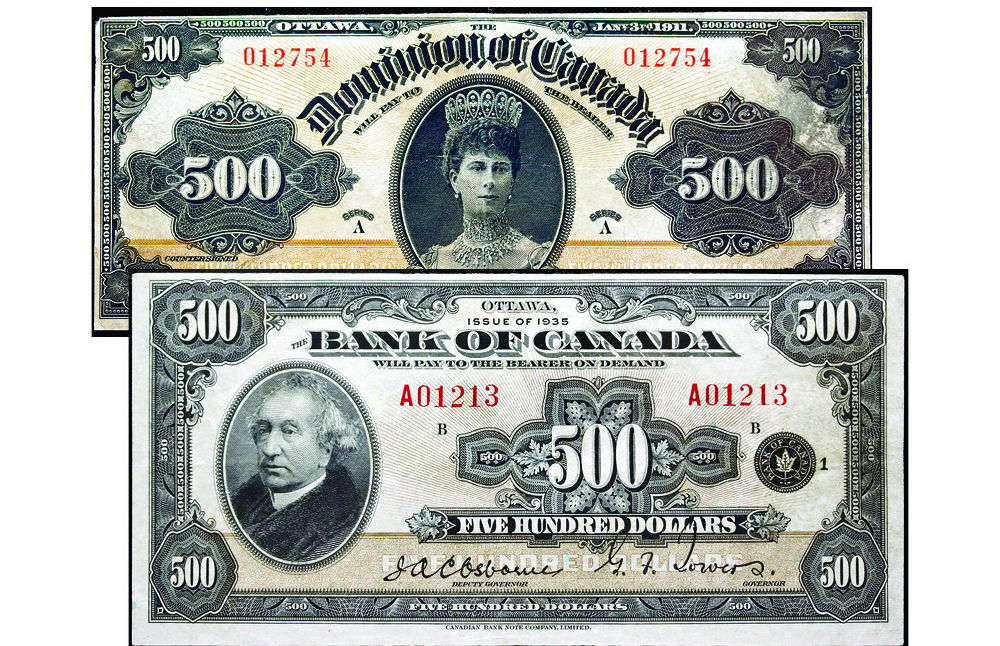By Jesse Robitaille
A pair of iconic Canadian banknotes, including the most sought-after issues from before and during the Bank of Canada era, are expected to sell for upwards of $200,000 at a Québec auction this June.
The offering includes what auctioneers describe as the “holy grail” of Dominion of Canada banknotes, the 1911 $500 bill (DC-19), plus the same denomination from the Bank of Canada’s inaugural 1935 Series.
“Ownership of the 1911 $500 note represents the ultimate collecting achievement in the field of Canadian currency,” said auctioneer Marc Verret, the owner of the Canadian Numismatic Company (TCNC), which is offering the so-called “Queen Mary” note during its fourth Prominence Sale on June 26-29.
“This may be the most impressive and most significant Dominion of Canada banknote ever offered in our auction.”
Slated to cross the block as Lot 412 during the sale’s second of four sessions, the 1911 $500 note is certified as Very Fine-20 by Legacy Currency Grading (LCG), a third-party paper money grading service founded in 2019.
“Until the discovery of this note, there were only three examples in private hands,” said Verret, who added no institutional collections – including the Bank of Canada’s National Currency Collection – hold an issued example (although the central bank does have both specimen and proof examples).
“Such an early rarity, especially in issued format, is certainly a tasty find for any serious collector and will most certainly serve as an absolute treasure in their collection.”
Another issued example – also in Very Fine condition and with a serial number reading “012735” – brought $322,000 US (about $344,000 Cdn.) as Lot 12893 of Heritage Auctions’ September 2008 “Long Beach” sale.
The example on offer this June, with serial number “012754,” is estimated at $100,000-$200,000. As of May 26, bidding had reached $65,000.
1935 SERIES
$500 NOTE
The other Canadian note with high expectations – the sought-after 1935 Series $500 bill (BC-17) – will cross the block as Lot 455.
Certified as Extremely Fine-45 PPQ (premium paper quality) by LCG, the note is described by auctioneers as “excessively rare and desirable, with only a handful of examples (known) to exist.”
The only $500 note issued by the central bank – formed in 1935 in response to the Great Depression – it features a face portrait of first prime minister John A. Macdonald plus a back vignette with a fertility allegory. Examples certified as Extremely Fine-40 are valued at $250,000 in the Charlton Standard Catalogue of Canadian Government Paper Money.
“Rarely does such a high calibre of eye-appeal intersect so perfectly with extreme rarity,” said Verret, who added interest levels for this issue are “beyond imagination.”
“This is only the third and best example we have ever offered in our auctions.”
It’s estimated at $100,000-$200,000, and as of May 26, bidding had reached $75,000.
Both the 1911 and 1935 issues come from the MacFayden Collection, which will be offered this June alongside the Max Brail Collection, the fourth part of the Gem Collection plus material from 65 other North American consignors.
“Values and limited quantities made these museum pieces even for the most hardened collectors,” Verret said.
To read the full story and others in this issue, click here and subscribe now.
Already a subscriber? Click here to continue reading in the digital format.

